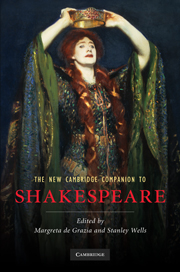Book contents
- Frontmatter
- 1 The traces of Shakespeare’s life
- 2 Shakespeare’s reading
- 3 Shakespeare’s writing: from manuscript to print
- 4 The theatre of Shakespeare’s London
- 5 The transmission of Shakespeare’s texts
- 6 Shakespeare and language
- 7 Shakespeare the poet
- 8 Shakespeare’s comedies
- 9 Shakespeare’s tragedies
- 10 Shakespeare’s English history plays
- 11 Shakespeare’s classical plays
- 12 Shakespeare’s tragicomedies
- 13 Shakespeare, religion and politics
- 14 Shakespeare and race
- 15 Shakespeare, sexuality and gender
- 16 Shakespeare on the stage
- 17 The critical reception of Shakespeare
- 18 Shakespeare and popular culture
- 19 Shakespeare and globalization
- 20 Shakespeare and media history
- 21 Shakespeare: reading on
- Index
12 - Shakespeare’s tragicomedies
Published online by Cambridge University Press: 28 January 2011
- Frontmatter
- 1 The traces of Shakespeare’s life
- 2 Shakespeare’s reading
- 3 Shakespeare’s writing: from manuscript to print
- 4 The theatre of Shakespeare’s London
- 5 The transmission of Shakespeare’s texts
- 6 Shakespeare and language
- 7 Shakespeare the poet
- 8 Shakespeare’s comedies
- 9 Shakespeare’s tragedies
- 10 Shakespeare’s English history plays
- 11 Shakespeare’s classical plays
- 12 Shakespeare’s tragicomedies
- 13 Shakespeare, religion and politics
- 14 Shakespeare and race
- 15 Shakespeare, sexuality and gender
- 16 Shakespeare on the stage
- 17 The critical reception of Shakespeare
- 18 Shakespeare and popular culture
- 19 Shakespeare and globalization
- 20 Shakespeare and media history
- 21 Shakespeare: reading on
- Index
Summary
'Exit, pursued by a bear' (The Winter's Tale, 3.3.57). This is one of the most famous stage directions in Shakespeare. It makes us laugh, while at the same time giving us a sense of puzzlement and wonder. What did that moment really feel like for early modern audiences at the Globe or Blackfriars? Was it a real bear or a man in a bear suit? Was it comic? Scary? Weird? Or all of these at once? We may begin by exploring something of the particular quality of Shakespeare's late plays through this stage direction and the rest of the scene that follows it in The Winter's Tale. Antigonus, who is the man pursued by a bear, has just laid down a baby, Leontes' child Perdita, whose life he has saved against Leontes' command. Her name tells us she is lost; yet her survival here as Antigonus himself meets violent death is a miracle. A shepherd comes on, finds the baby and 'take[s] it up for pity' (3.3.72-3); at which point his son comes on, amazed by the dark side of this wonder: 'I have seen two such sights, by sea and by land! But I am not to say it is a sea, for it is now the sky. Betwixt the firmament and it you cannot thrust a bodkin's point' (3.3.79-81). Why does Shakespeare give the shepherd's son all these words to say that he has seen something amazing? All he is saying, in fact, is that the sea meets the sky at the horizon, which is as ordinary and predictable an observation as can be.
- Type
- Chapter
- Information
- The New Cambridge Companion to Shakespeare , pp. 169 - 184Publisher: Cambridge University PressPrint publication year: 2010
- 2
- Cited by



